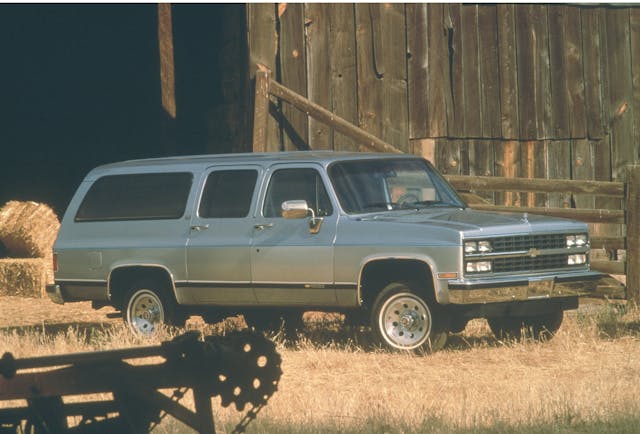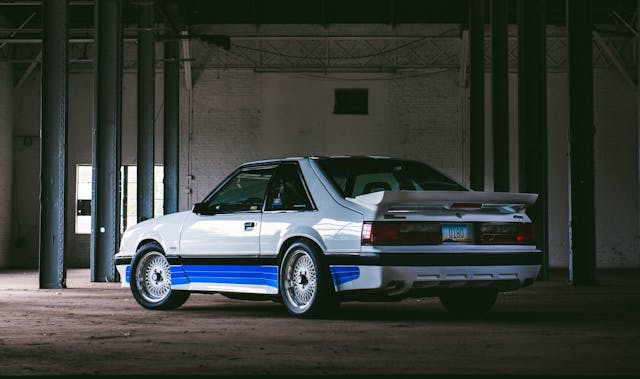5 vehicles that prove the market hasn’t lost steam
Despite continued external variables threatening to put a damper on enthusiasm for buying collector cars, the latest quarterly update of the Hagerty Price Guide indicates a continued strong, if slightly more rational, market. The 2022 Monterey auctions saw their best-ever year and demand for collector vehicles remains strong. While some of the gains were a tad more restrained than in previous editions of the Price Guide, the sub-$50,000 market in particular saw a number of healthy increases, helping indicate that overall the market remains healthy. Here are a few highlights and notable movers from the latest edition.
1973–1991 Chevrolet/GMC Suburban: +18 percent

With one generation spanning eighteen years, “square body” Suburbans are one of the most recognizable classic utility vehicles that don’t carry the Jeep name. A utilitarian workhorse and family cruiser, the Suburban combines truck and station wagon into one package. From fleet grade to downright cushy for the era, a wide selection of trim levels meant you could spec your Suburban exactly how you wanted.
Perhaps it’s their size, or how common they once were, but Suburban values have lagged behind those of their smaller Jeep competitors, remaining relative bargains in the utility wagon world. It was only a matter of time for the Suburban, though, especially with its pickup counterparts and Blazers steadily rising over recent years. While it seems unlikely we will see Blazer-level prices out of Suburbans, don’t expect these trucks to be any cheaper moving forward.
1967–1970 Toyota 2000GT: +20 percent

Toyota’s 2000GT is without a doubt the grandfather of Japanese collector cars. It is one of the earliest Japanese cars to be widely accepted as a serious collector model and accordingly has ventured into previously unimaginable values for a Japanese car. A few models like the Lexus LFA and certain editions of the Nissan Skyline GT-R have joined ranks with the 2000GT, but with the global car community only recently warming to Japanese metal, there is still room for growth in this market.
The 2000GT’s path hasn’t always been ascendant, though: We have observed wild swings over the years, from a top-flight car going for $1.1M in 2015 to another #1 condition sale failing to clear $800,000 in early 2017. While these cars only infrequently become available, successive sales this summer both on Bring a Trailer and in-person in Monterey demonstrate the 2000GT’s triumphant comeback, placing values north of $1M once again.
1981–1993 Volvo 240: +22 percent

Volvo brick owners everywhere, rejoice! These cars have been gaining traction over the course of the last year but have really picked up speed this past quarter. These highly practical, over-engineered boxes on wheels are a total nostalgia trip for anyone who grew up in the ’80s and ’90s. But their appeal is far broader than that: Based on insurance quotes, it’s nearly a dead-even spread of baby boomers through Gen-Z who are interested in these cars.
This appeal has driven a ton of these cars into the online auction space, where some real gems have popped up for sale. Granted, your average 240-series is still a cheap collector car, but now you’re going to have a hard time picking one up for the value of your pocket lint. A good car can set you back close to ten grand, and that’s still a car with over 150,000 miles. If you want an actual low-mile car, we’ve seen sales exceed $40,000, although that’s a unicorn. It’s unlikely that these cars will go truly bonkers value-wise (although one could argue they already have, compared to where they were), but it’s safe to say that the 240 has successfully transitioned from a bulletproof family commuter to a bulletproof, fun collector car.
1993–1998 Jeep Grand Cherokee: +32 percent

We didn’t see this coming, either. 1990s Jeep Grand Cherokees have long been a staple of robust, affordable, 4×4 daily driving. The ZJ-Series Grand Cherokee was also the subject of one of the most memorable car unveilings of all time: Then-president of Chrysler Bob Lutz drove up the steps of Detroit’s Cobo Hall and through the building’s plate glass window to unveil the new model. Like Lutz’s entry, the Grand Cherokee was a smash hit with the public and absolutely proliferated the 4×4 market, making the Grand Cherokee name the success it is today.
Considering that the vintage truck and SUV market has been white hot for some time, that the ZJ is seeing an increase should surprise no one. Let’s be clear—cheap, heavily-used examples are still out there, but for exceptionally well-cared-for examples, prices into the teens to over $20,000 are no longer unheard of. History shows us that Jeep wagons are incredibly popular among enthusiasts, so it’s likely this trend will continue.
1984–1993 Ford Mustang Saleen: +40 percent

Others at Insider may disagree, but the Fox-body Mustang has got to be the greatest classic Mustang since the original hit the roads in the 1960s. Like its predecessor, it brought affordable performance to the masses. Perhaps just as importantly, after the ungainly Mustang II, the Fox-body looked like a true pony car. But unlike the 1960s, the Mustang didn’t have a go-to tuner to spice things up: Carroll Shelby was now helping Chrysler spice up its K-cars.
Into that void stepped Steve Saleen. Like the Shelby Mustangs two decades before, Saleen Mustangs were tweaked in Saleen’s shop but offered through Ford dealers. Geared toward racing and cornering versus straight-line speed, the majority of upgrades were handling-related, although later versions saw noticeable power bumps. Their rarity and a better understanding of their significance in the Mustang story among average collectors is likely fueling this bump in values. It’s worth noting, though, that Ford’s in-house track monster, the 1993 Cobra R, saw its own values appreciate ahead of the Saleen Mustangs and commands higher prices in large part due to its even more rare status.
Regardless of the reason for the ascendent Saleen values, it seems likely that this sudden rise is far from a fluke. Consistent offerings of excellent examples show that the gap between the Cobra R and Saleens is rapidly closing. Don’t be surprised if there is more room for growth.
Check out the Hagerty Media homepage so you don’t miss a single story, or better yet, bookmark it.



Steve Saleen = Carroll Shelby in 20 years….
In some states cars older than 25 years can be titled and tagged as “Historic”. They also can get tags without inspection. This allows drivers to put rusty, mechanically unsafe clunkers on on the road. They are relatively cheap to buy and are kept together with wire and duck tape, but they are allowed due to their “Historic” classification. You see them everywhere across our state.